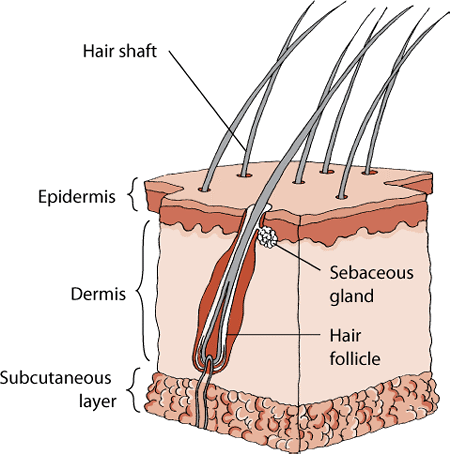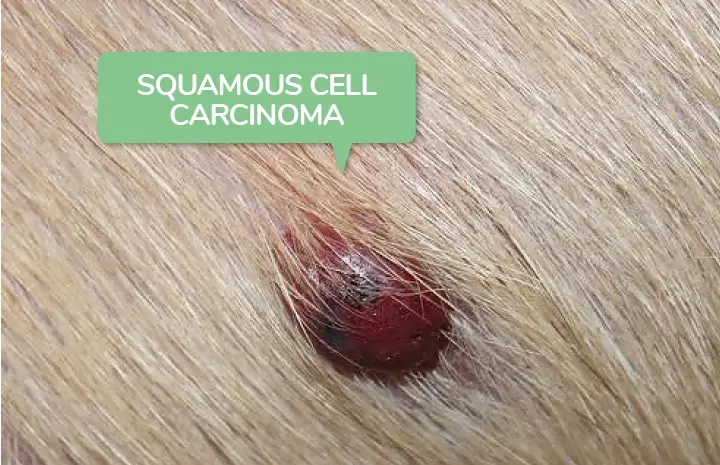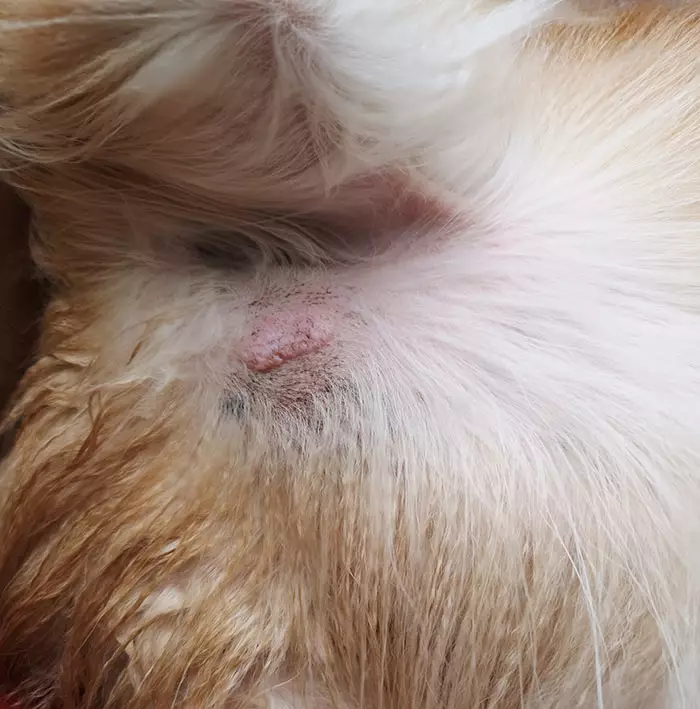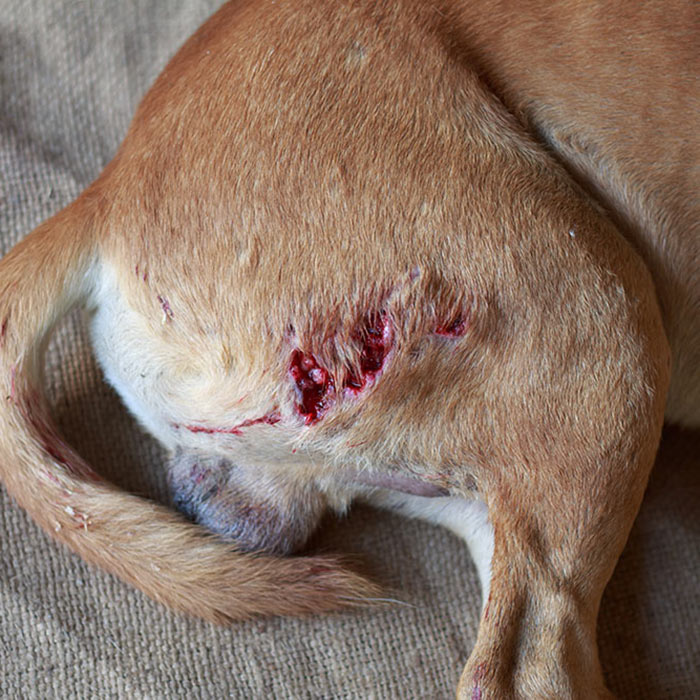Squamous cell carcinoma in dogs
What is squamous cell carcinoma?
Carcinomas are cancers that develop in cells which cover the internal organs and outer surfaces of the body. A squamous cell carcinoma is a form of skin cancer; more specifically it is a malignant tumour in the epidermal cells of the skin. The skin consists of several layers, of which the outermost layer, or epidermis, contains scale-like cells called the squamous epithelium. A squamous cell carcinoma is so named because it is an uncontrolled growth of abnormal cells originating from the squamous cells in the epidermis.
Squamous cell carcinomas in dogs often appear as a white skin mass or a raised lump on the skin, in the nail beds of the toes, or in the mouth. The mass may bleed or ulcerate as the condition progresses. In dogs, squamous cell carcinomas are the most frequently diagnosed carcinomas.

Squamous cell carcinoma in dogs; Structure of the skin in dogs
Source: https://www.merckvetmanual.com/-/media/manual/veterinary/images/ddd_dog_skin_anatomy.gif
Squamous cell carcinomas are defined by their location on the body:
Cutaneous squamous cell carcinoma
Cutaneous is the scientific word for “related to or affecting the skin.” These are generally slow-growing yet aggressive tumours that occur in the skin, especially under-pigmented areas where hair is sparse and where there is a high rate of exposure to sunlight. Most cutaneous squamous cell carcinomas appear on the head, limbs, abdomen (underside) and perineum. Tumours appear as firm, raised, often ulcerated lesions and nodules that frequently grow outward and have a wart-like surface.
Cutaneous squamous cell carcinomas are more common in older dogs, with Bloodhounds, Keeshonds, Standard Schnauzers, Standard Poodles, Basset Hounds and Collies at greatest risk. Short-coated dogs that spend lengthy periods of time outdoors also have a higher incidence. No sex predisposition has been found.
Subungual squamous cell carcinoma
These are slow-growing tumours that arise in the epithelial layer of the nail bed. They may occur on multiple toes and limbs, and in around 13% of cases they metastasise to the lymph nodes and lungs. This is the most common form of squamous cell carcinoma, accounting for about 50% of digital tumours in dogs. Both the fore and hind limbs are equally predisposed to tumour development.
Breeds with increased incidence of Subungual squamous cell carcinoma include Giant, Standard and Miniature Schnauzers, Gordon Setters, Standard Poodles, Scottish Terriers, Kerry Blue Terriers and Briards. Generally, these are dark-haired breeds, and a dark coat colour has been associated with the occurrence of subungual squamous cell carcinomas. Females have a slightly higher rate of occurrence.
Oral Squamous cell carcinoma
These are squamous tumours that occur in the mouth or throat, and are most commonly located in the gums or tonsils. They can metastasise, depending on their location, and may invade the bone. Breeds with increased incidence include English Springer Spaniels and Shetland Sheepdogs, and more frequently develops in older neutered females.
Symptoms of squamous cell carcinoma in dogs
Symptoms may vary depending on the location of the tumour. They may also be difficult to spot or distinguish from other sores, ulcers, bumps, or lesions. Squamous cell carcinomas in dogs may be found anywhere on the body, with typical locations being the nose, toes, legs, scrotum and anus.
Common symptoms of squamous cell carcinomas in dogs include:
- A firm, raised, wart-like lump or nodule
- Sores in areas where hair is white or light in colour
- White growths or skin masses
- Erosive and ulcerated skin lesion, rather than a lump
- Growths on the nose, toes, legs, scrotum, or anus
- Inflamed, crusty or bleeding sore that do not heal, even with antibiotics or creams
- Swelling and pain of the nailbed
- Loss of the nail
- Limping or pain when walking
- Lameness
- Excessive drooling
- Difficulty eating or swallowing
- Mild or nagging cough
- Swollen, bleeding or inflamed areas in the mouth
- Loose teeth
- Oral bleeding
- Halitosis (bad breath)
Causes of squamous cell carcinoma in dogs
It can be difficult to identify the exact cause of squamous cell carcinomas as there are a number of genetic and environmental factors that may contribute. These are some of the risk factors which may increase the dog’s likelihood of developing squamous cell carcinoma:
Age:
- The mean age for diagnosis of squamous cell carcinoma is between 6 and 11 years old
- Risk generally increases with age
Exposure to ultraviolet light or sunlight:
- Tumours often develop in areas of skin most exposed to sunlight (UVA and UVB radiation)
- More common in outdoor dogs, dogs that spend a lot of time in the sun and those living at high altitude
Physical characteristics associated with increased risk:
- Short haired
- Light coloured skin and hair
- Dark coloured coats
Breed susceptibility:
- Large breed dogs
- Large breed black dogs are more prone to squamous cell carcinomas on their toes
Other medical conditions that may increase risk:
- Compromised immune system
- Papilloma virus
How is squamous cell carcinoma in dogs diagnosed?
An accurate diagnosis will help in determining the outcome of squamous cell carcinoma in dogs. A thorough history of the dog’s health should be provided, and a complete blood count and blood chemistry profile should be performed to identify any abnormalities. Accurate diagnosis relies upon microscopic examination of tissue samples, as well as medical imaging such as x-rays.
Physical examination:
- A thorough inspection of the dog’s skin, to identify any growths or sores that have not healed over time.
- Palpation of lymph nodes to detect swelling, which may indicate the presence of disease or infection.
Cytology:
- Microscopic examination of tissue to determine the type of tumour is essential for accurate diagnosis.
- Tissue may be taken by means of fine needle aspiration with cytology (FNAC), punch biopsy (the primary technique for obtaining skin samples) or complete resection (removal) of the suspected tumour.
- A sample of lymph fluid may also be analysed.
Medical imaging:
- Chest and abdominal x-rays may be performed to inspect the lungs and other organs, in case of metastasis (spread of the cancer).
- For oral squamous cell carcinoma, x-rays of the mouth and jaw to determine the degree of invasiveness of the lesion.
- For tumours on the legs, x-rays of the leg to see if the cancer has spread to the bone underneath it.
- Computed tomography (CT) may be undertaken to evaluate the location and extent of tumour, particularly those of the ear canal, oral and sino-nasal cavities.
- Imaging can also be useful for the planning of surgery and radiation treatment.
Prognosis
The prognosis will vary, depending on the size and location of the tumour, as well as the probability of recurrence of the cancer in the same area or metastasis (spread) to other areas. As carcinomas are normally malignant and predominantly invasive, life expectancy is also affected by any delay in diagnosis and onset of treatment. Malignant cancers can spread to the local lymph nodes, and then throughout the body via the blood, lymph fluid and nerves. Often the immune system is compromised, which facilitates the cancer’s progress.
Canine squamous cell carcinomas of the skin are typically only locally aggressive with a low potential for distant metastasis. Where the tumour is well-differentiated (the cancer cells look more like normal cells) and can be completely excised, the prognosis is favourable. Conversely, the prognosis is poor if the tumour is inoperable or poorly differentiated or has metastasised. Any recurrence is usually seen within weeks to months.
Nail bed squamous cell carcinomas may recur in the same or another digit from months to years later; they also have a greater likelihood of metastasising, even after surgical removal or amputation, because they can spread up the nerves. Prognosis for oral squamous cell carcinoma depends on the location of the tumour and its rate of metastasis. If the tumour is not located in the tonsils and has not metastasised, the prognosis is positive with surgery and/or radiation treatment. However, tumours that originate in the tonsils tend to be aggressive and have a poor prognosis; they tend to spread to regional lymph nodes.

Squamous cell carcinomas in dogs.
Source: https://www.dogsnaturallymagazine.com/dog-skin-cancer-natural-options-that-work/
Treatment for squamous cell carcinoma in dogs
Treatment for squamous cell carcinomas in dogs depends upon the location of the tumour, its size, and whether it has spread. The most common form of treatment is surgical removal. If sores are diagnosed before they become cancerous, they can be treated with topical medication. If a tumour cannot be surgically removed, treatment may entail chemotherapy and / or radiation. The veterinarian will determine the best course of action.
Surgical excision:
Surgical excision is the primary treatment option for squamous cell carcinomas in dogs. Successful removal of the tumour depends on factors such as its size and location. Wide surgical excision, with margins of at least 2 cm around the tumour, is usually curative.
Some cases will necessitate a more severe removal of tissue. For example, tumours located on the toes require amputation of the affected toe, those on the nose will require a partial removal of the nose, and if the tumour is found on the ear, part of the ear will be removed. In cases of oral tumours, the tumour and some of the underlying tissue and bone are removed; sometimes part of the jawbone is excised.
Other than an altered cosmetic appearance, most dogs recover well from these surgeries. Surgery is considerably successful if the margins are clear; that is, no cancer cells are present in the outer edge of the removed tissue. Even if surgery isn’t curative, surgery can prolong survival.
Radiation therapy:
Radiation therapy is usually recommended in addition to surgery if the tumour is not completely removed. It may also be used as a primary treatment for inoperable tumours. Radiation is most commonly used for tumours of nose and oral cavity. Small, early-stage tumours respond best to this treatment.
Chemotherapy:
While squamous cell carcinomas are not generally regarded as chemo-responsive, chemotherapy may be added to therapy, depending on the circumstances. If the tumour cannot be entirely removed or is inoperable, the veterinarian may recommend chemotherapy. In these situations, the chemical treatment will keep the tumour from growing as quickly and help to make the dog more comfortable.
Alternative therapies:
Alternative treatment may be used where the position of the tumour precludes successful surgery, such as the nose, face, or eyelids. These include cryosurgery, a freezing technique, and photodynamic therapy, a type of light therapy. These therapies can in some cases also be used successfully where the dog has a small, superficial tumour that has not spread to other organs.
On-going management and care:
- Pain medication may be prescribed during treatment and / or after surgery.
- The dog’s physical activity will need to be restricted during the recovery period – set aside a quiet place for rest, away from household activity, children, and other pets; cage rest may be beneficial.
- Only take your dog for short walks until advised otherwise by the vet.
- Monitor the dog’s food and water intake while it is recovering; a feeding tube or a high protein liquid supplement may be necessary to ensure adequate nutrition.
- Topical medication may need to be applied to any lesions or sores.
- Limit the amount of time the dog spends in the sun, especially between the hours of 10:00 am and 2:00 pm, when the sun is at its highest and the rays most damaging.
- When taking the dog outdoors during daylight hours, apply sunscreen to the ears, nose, and other areas that are either lightly furred or coloured.
- Regular follow-up examinations will be scheduled in order check for any new skin tumours, and x-rays of the chest and abdomen will be taken to see if there are any new tumours in the lungs or internal organs.
- If any new sores or masses are observed, take the dog to the vet immediately so that treatment can commence as soon as possible.
In a nutshell
Squamous cell carcinomas are common tumours in dogs, often appearing as a mass or raised lump on the skin, in the nail beds of the toes or in the mouth. They are malignant cancers that are typically locally aggressive, although they metastasise slowly. Tumours in the nail bed, however, grow more quickly and are more challenging to treat.
The cause of a squamous cell carcinoma in dogs is difficult to determine, as there are several genetic and environmental factors that are associated with the development of the condition. Dogs that are aged 6 to 11 years old and large breed dogs with dark coats are most at risk, as are those with prolonged exposure to sunlight and those with light coloured skin and hair and sparse fur.
Early recognition, diagnosis and treatment of squamous cell carcinoma are essential. Diagnosis relies on microscopic examination of the tumour. A number treatment modalities are available, depending on the size, location and spread of the tumour. The most common treatment is surgical removal of the tumour. The prognosis for dogs with squamous cell carcinomas varies. Prognosis is good for those with well-differentiated tumours that can be completely excised and have not spread; prognosis is poor for dogs with inoperable or poorly differentiated tumours or with metastasis.
Bow Wow Meow Pet Insurance can help protect you and your dog should an unexpected trip to the vet occur.
-
Find out more about our dog insurance options
-
Get an online pet insurance quote


More information
https://www.petmd.com/dog/conditions/cancer/c_dg_squamous_cell_carcinoma_skin
https://vcahospitals.com/know-your-pet/squamous-skin-cell-carcinoma-in-dogs
http://www.vetfolio.com/oncology/squamous-cell-carcinoma https://wagwalking.com/condition/skin-cancer-squamous-cell-carcinoma
https://www.skincancer.org/skin-cancer-information/squamous-cell-carcinoma








